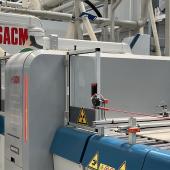The future of Ceramics, seen from near
Last Wednesday (25th September) over 260 people from 43 different countries attended a Sacmi-organised conference titled "Ceramics: your future seen from near": specially arranged for Sacmi customers and held at the Imola headquarters, it offered a unique opportunity for an up-to-date overview of the Sacmi Group's latest developments for the tile industry.
After an analysis of growth dynamics within static economies, with particular emphasis on China, conducted by Alex Murphy, a researcher from the prestigious magazine Asian Ceramics, the conference examined Sacmi's latest proposals for facing up to the challenges of the future, especially those of output flexibility and energy savings.
To compete on the globalised ceramic tile market it is becoming ever-more necessary to have a wide product range with numerous sizes and decorative solutions and, at the same time, an output set-up that contains costs. And Sacmi's plant engineering proposals for maximising output flexibility are visible in the recent introduction of lines for large-size porcelain tiles: these provide various advantages, such as ease of management, the higher value of the attainable products, the possibility of producing modular sub-sizes via cutting without having to change the die and less need for finished product storage facilities.
Sacmi's extensive range of large-size tile manufacturing solutions was illustrated by Andrea Bresciani, Sacmi Imola's Technological Manager, during his talk titled "High flexibility in the production of tiles and large ceramic slabs: new plant proposals". The talk spanned from traditional lines with the PH10000 high-tonnage press and fast die changeover to the now tried-and-tested Continua line and the all-new Continua+, that is the new Sacmi roller-compaction-only technology that lets manufacturers produce ultra-large sizes at outstanding levels of productivity.
The new Continua and Continua+ technologies can, moreover, be perfectly integrated with even the latest innovative digital decoration technologies such as Dry Digital Decoration, Digital Glazing and Inkjet Decoration, the focal points of a talk by Davide Medici (Managing Director of In.Te.Sa., Sacmi's digital specialist) titled "Glazing and decoration in the digital era: an integral process".
Now, with the introduction of the COLORA HD Black, digital decoration - already firmly established thanks to undisputed advantages such as high-res graphics, easy prototype construction and fast product changeovers, even with small lots, plus contactless decoration even on textured surfaces - has climbed yet another rung up the innovation ladder. Yet the real decoration revolution will be made possible thanks to the introduction of Sacmi digital glazing, which effectively reduces line length, enhances automation and simplifies management. Digital glazing allows not only the traditional application of glazes and engobes but, above all, the creation of ceramic surfaces with new chromatic and optical.
But output flexibility, of course, needs to be complemented by energy savings. Hence the fourth talk (by Andrea Avallone, Managing Director of Sacmi Forni, titled "The EKO kiln: plant evolution"), which analysed the energy-saving advantages to be gained with the Eko kiln, a machine featuring technology that completely modifies fume flows inside the kiln to cut fuel consumption while improving output quality, thus introducing a radical and innovative transformation of the traditional tile firing process.
Savings were also the subject of the last talk ("EkoWrap: the new frontier in packaging" by Maurizio Bardi, Managing Director of Nuova Sima). This focussed on end-of-line solutions provided by Nuova Fima. The new EkoWrap and EkoRoll, in fact, introduce the peripheral packaging concept, which uses two corrugated cardboard blanks and a patented closure system to allow even very large tiles to be packaged. This smoothly combines considerable cost reduction with size changeovers, able to be completed in just a few minutes: that means reduced cardboard stocking requirements, increased line productivity and, of course, optimal tile corner protection.
Switching from theory to practice, the conference ended with a visit to the Sacmi plant where participants had the opportunity to see the EkoWrap and EkoRoll packaging machines in action. Also on display was the COLORA HD BLACK digital printer, the most recent evolution of the COLORA machine series that, thanks to the installation of up to 8 colour bars, provides an outstanding response to the digital decoration needs of the ceramic industry. Visitors were also treated to a preview of the prototype of the new COLORA HW printer, the first machine in the world for the application of water-based ceramic glazes. The COLORA HW can be used for the controlled application of glazes and engobes to create relief structures and surfaces or complete final decoration of ceramic pieces. Glaze application may be all-over or focus on enhancing graphics via the digital application of inks.
The event ended with aperitifs in the suggestive setting of the cloisters of the Basilica di Santo Stefano. These were followed by a gala dinner at Palazzo Isolani, in the heart of Bologna's historic city centre, giving Sacmi's guests a great opportunity to discover some of the gems of Bologna's unique architectural heritage.




Did you find this article useful?
Join the CWW community to receive the most important news from the global ceramic industry every two weeks





















